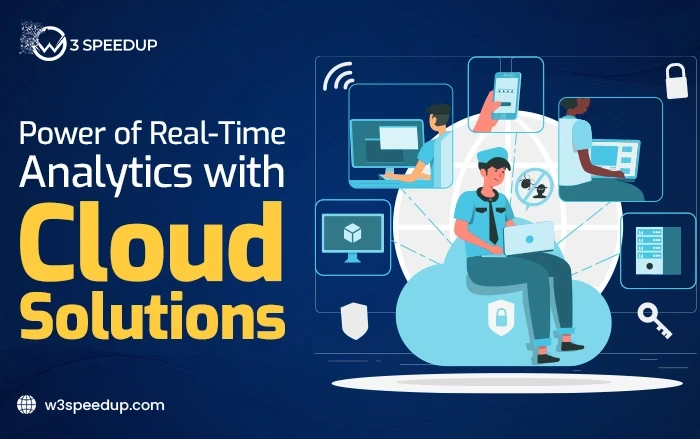In the digital age, the ability to swiftly analyze and respond to data has become a cornerstone of successful business strategies. Real-time analytics, supported by robust cloud analytics solutions, represents a transformative approach to accessing, analyzing, and acting upon data as it is generated.
This capability is not merely an upgrade to existing systems but a necessary evolution in our fast-paced world. The importance of real-time data processing is underscored by its impact on decision-making, operational efficiency, and customer satisfaction.
As businesses strive to maintain a competitive edge, integrating real-time analytics with advanced cloud technologies becomes essential, making cloud analytics a pivotal aspect of modern business intelligence.
Real-Time Analytics and Cloud Solutions: Navigating Insights, Integration, and Evolution
1. Understanding Real-Time Analytics
Real-time analytics refers to the ability to process and analyze data at the moment it is captured, offering immediate insights and the potential to influence outcomes proactively. Unlike traditional analytics, which often involves delays due to data batching and processing, real-time analytics provides instantaneous results, thereby enabling businesses to make more informed decisions quicker.
This speed is critical in environments where conditions change rapidly, such as financial markets or online consumer behavior. Real-time cloud analytics empowers organizations to respond to events as they happen, enhancing their agility and responsiveness in dynamic markets.
The immediate feedback loop created by real-time data analysis helps businesses to fine-tune strategies and operations on the fly, ensuring optimal performance and customer satisfaction.
2. The Cloud Infrastructure
Cloud computing has revolutionized many aspects of technology, with analytics being one of the most impacted areas. By leveraging cloud environments — be it public, private, or hybrid — organizations can benefit from major scalability, flexibility, and cost savings.
Cloud solutions provide the necessary computational power and storage capacity on-demand, removing the barriers of on-premise infrastructures that are often expensive and less adaptable. The elasticity of cloud resources ensures that businesses can scale their analytics capabilities in line with demand, avoiding the pitfalls of over-provisioning or under-utilization.
Furthermore, cloud platforms offer advanced security features and compliance certifications that help businesses meet regulatory requirements while safeguarding their data. The integration of cloud technologies with real-time analytics not only enhances performance but also simplifies the management and maintenance of analytical infrastructure.
3. Integration of Real-Time Analytics and Cloud Solutions
The integration of real-time analytics with cloud solutions enables businesses to harness powerful analytical tools without the need for substantial upfront investment in physical hardware or lengthy setup times. Cloud platforms like
Amazon Web Services (AWS), Microsoft Azure, and Google Cloud offer specialized services such as AWS Kinesis, Azure Stream Analytics, and Google BigQuery. These tools are designed to handle massive streams of data in real time, allowing businesses to observe trends, detect anomalies, and respond to events as they occur.
For instance, a retail company might use these technologies to monitor inventory levels across hundreds of stores in real-time, automatically adjusting orders and stock transfers according to predicted demand spikes and drops. Similarly, financial institutions process millions of transactions each day, and using real-time analytics, they can instantly detect fraudulent activities and prevent potential losses.
4. Impact on Business Decision Making
The advantages of real-time analytics extend beyond mere operational adjustments; they fundamentally enhance decision-making capabilities. By having immediate access to data insights, executives can make more informed, evidence-based decisions. For example, marketers can tweak campaigns in real-time based on immediate feedback on customer engagement and conversion rates, significantly increasing the ROI of their marketing efforts.
Real-time analytics also play a critical role in enhancing customer satisfaction. Businesses can anticipate needs, personalize interactions, and resolve issues faster, leading to improved customer experiences. For instance, telecom operators analyze call drop data as it happens to identify and resolve network issues before they affect a large number of customers.
5. Challenges and Considerations
Despite its benefits, the adoption of real-time analytics and cloud solutions is not without challenges. Data security and privacy are major concerns, especially under stringent regulations like GDPR in Europe or CCPA in California. Businesses must ensure that their real-time data processing complies with all legal standards and that robust cybersecurity measures are in place.
Furthermore, integrating real-time analytics into legacy systems can be complex and costly, requiring careful planning and execution. There is also a significant demand for skilled professionals who can manage these sophisticated systems and derive actionable insights from vast quantities of data.
6. Future Trends in Real-Time Analytics
As technology evolves, the scope of real-time analytics is expanding. Artificial Intelligence (AI) and Machine Learning (ML) are increasingly integrated into real-time systems, making them more accurate and capable of predictive behaviors rather than just reactive responses. For example, AI models can predict customer churn by analyzing transaction patterns and customer interactions as they happen, enabling proactive retention strategies.
Looking ahead, industries such as manufacturing, healthcare, and logistics stand to gain substantially from advancements in real-time analytics. Smart factories, for instance, could use real-time data to optimize production processes and reduce downtime through predictive maintenance on equipment.
Conclusion
Real-time analytics empowered by cloud solutions are reshaping the landscape of business across industries. By enabling instant data processing and analysis, organizations can not only keep pace with the speed of information but also anticipate future trends and react to changes in real-time. The move towards these technologies is not merely beneficial but essential for companies aiming to maintain competitive advantage in a rapidly evolving market.
For businesses contemplating this shift, the journey involves careful consideration of their specific needs, potential risks, and the readiness of their current systems to integrate with advanced cloud-based analytics solutions. However, the potential rewards—enhanced efficiency, improved decision-making, and superior customer engagement—make the pursuit of real-time analytics a worthy endeavor in the digital era.
 Christmas Mega Sale – Enjoy Up to 50% OFF on Every Plan!
Christmas Mega Sale – Enjoy Up to 50% OFF on Every Plan! 



